
In recent years, the concept of Web3 has been gaining significant attention, promising to revolutionize the way we interact with the internet. Unlike its predecessors, Web1 and Web2, which were primarily centralized and controlled by a few powerful entities, Web3 embraces decentralization, offering a more democratic and transparent online ecosystem.
We are currently moving toward Web 3.0, also known as the semantic or decentralized web. It’s a paradigm shift rather than merely an update. The goal of Web 3.0 is to build a smart, context-aware, and user-experience-specific internet.
On this internet, users control their own data, information is dispersed, and digital interactions are just as complex and nuanced as those between people. In this blog post, we’ll delve into the potential of Web3 and explore how it could shape the future of the Internet.
Understanding Web3
Web3 represents the next evolutionary phase of the internet, characterized by decentralized protocols, Blockchain technology, and peer-to-peer networks. At its core, Web3 aims to redistribute power from centralized authorities to individual users, enabling greater autonomy, privacy, and security. By eliminating the need for intermediaries and introducing trustless transactions, Web3 has the potential to foster innovation across various industries, including finance, healthcare, and entertainment.
Key Features in Web3
- Decentralization: Unlike traditional web platforms controlled by centralized entities, Web3 operates on decentralized networks, where data is distributed across multiple nodes, ensuring greater resilience and censorship resistance.
- Blockchain Technology: Blockchain serves as the underlying technology powering Web3 applications, providing transparent and immutable ledgers for recording transactions and digital assets. Through smart contracts, users can execute programmable agreements without the need for intermediaries.
- Tokenization: Web3 enables the creation and exchange of digital assets known as tokens, representing ownership rights, utility, or value within decentralized ecosystems. These tokens facilitate incentivization, governance, and economic participation in various decentralized platforms.
- Smart Contracts: Smart contracts are self-executing agreements coded on Blockchain platforms that automatically execute and enforce the terms of a contract when predefined conditions are met. Smart contracts find applications across various domains, including finance, supply chain management, and decentralized applications (dApps).
- Interoperability: Interoperability is a crucial aspect of Web3, enabling seamless communication and data exchange between disparate Blockchain networks and protocols. Standards such as cross-chain interoperability protocols, atomic swaps, and interoperable token standards (e.g., ERC-20, ERC-721) facilitate interoperability, allowing users and applications to interact with multiple Blockchain ecosystems effortlessly. Interoperability enhances the scalability, utility, and composability of decentralized applications and ecosystems.
- Privacy and Security: Web3 prioritizes user privacy and security, offering solutions to mitigate risks associated with centralized data storage and control. Technologies such as Zero-Knowledge Proofs, decentralized identity management, and privacy-preserving protocols enable users to maintain control over their personal data while participating in decentralized networks. By minimizing reliance on trusted intermediaries and enhancing cryptographic privacy, Web3 enhances user sovereignty and reduces the risk of data breaches and surveillance.
- DAO: Web3 introduces novel governance models that empower participants to collectively govern and steer decentralized networks and protocols. Decentralized Autonomous Organizations (DAOs) are autonomous entities governed by smart contracts and token holders, enabling transparent decision-making, resource allocation, and protocol upgrades. DAOs embody principles of open participation, meritocracy, and community governance, fostering a more inclusive and democratic approach to network governance.
Unlocking the Potential in Web3
- Financial Inclusion: Web3 democratizes access to financial services through decentralized finance (DeFi), enabling global participation in lending, borrowing, and trading.
- Data Ownership and Privacy: Web3 empowers individuals with greater control over personal data, ensuring privacy and fair compensation through decentralized identity solutions and data marketplaces.
- Content Creation and Distribution: Web3 introduces new models for creators to monetize their work directly, leveraging Blockchain technology for transparent attribution and token-based incentives.
- Supply Chain Transparency: Web3 enhances supply chain transparency and traceability, ensuring authenticity and ethical sourcing through Blockchain-based provenance tracking.
- Democratic Governance: Web3 fosters transparent and inclusive governance through Decentralized Autonomous Organizations (DAOs), enabling stakeholders to collectively govern decentralized networks and protocols.
- Immutable Recordkeeping: Web3 provides tamper-proof and auditable recordkeeping through Blockchain technology, ensuring data integrity and digital trust across various domains.
Impact on Industries
- Finance and Banking: Decentralized finance (DeFi) platforms could disrupt traditional banking by providing financial services without intermediaries. Smart contracts and Blockchain technology enable peer-to-peer lending, borrowing, trading, and other financial activities. This could increase financial inclusion and reduce barriers to entry for individuals and businesses.
- Travel Booking: Decentralized travel booking platforms could offer more transparent and cost-effective options for travelers. By utilizing Blockchain technology, these platforms could provide direct connections between travelers and service providers, eliminating the need for intermediaries like online travel agencies (OTAs). Smart contracts could automate booking processes, ensure trustless transactions, and reduce fees.
- Real Estate: Decentralized platforms could streamline property transactions by eliminating the need for intermediaries such as brokers and lawyers. Smart contracts can automate tasks like property title transfers, escrow, and rental agreements, reducing costs and increasing efficiency.
- Healthcare: The decentralized web can revolutionize healthcare by securely storing and sharing patient records on Blockchain networks. Patients would have greater control over their data, while healthcare providers could access accurate, real-time information, leading to better diagnoses, treatment, and research.
- Supply Chain and Logistics: Blockchain technology can improve transparency and traceability in supply chains. By recording every transaction on a decentralized ledger, stakeholders can verify the origin and authenticity of products, ensuring ethical sourcing, reducing fraud, and enhancing efficiency.
- Media and Entertainment: Web3 could empower content creators by enabling direct peer-to-peer transactions between creators and consumers. Blockchain-based platforms for music, videos, art, and other content could ensure fair compensation, copyright protection, and transparent royalty distribution.
Conclusion
Web3, empowered by Blockchain, promises revolutionary shifts in many industries, promoting openness and usability. It has a broad impact on everything from travel to finance, democratizing procedures, and giving users more power. However, challenges like regulatory frameworks and scalability continue to exist, necessitating cooperative solutions. By working together, we can overcome these obstacles and realize the full potential of Web3, building a digital ecosystem that is more equitable, effective, and inclusive for everybody.
If you have any requirements in Web3, then connect with our Blockchain Development Experts.


